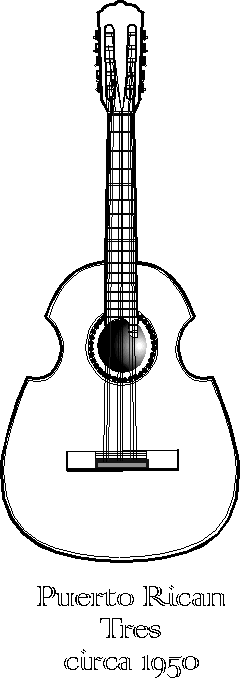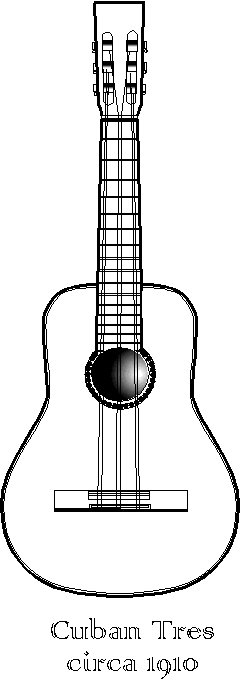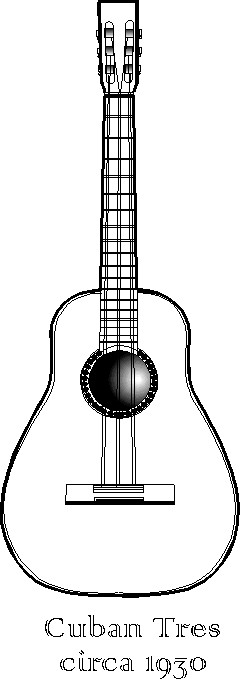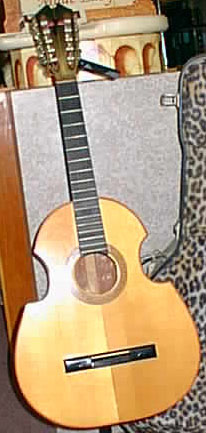



Puerto Rican Tres
A Little-known Fretted Instrument: The Tres
The Tres is generally unknown among many otherwise knowledgeable fans and connoisseurs of fretted stringed instruments, yet it is a vital expressive tool that has shaped the sound of Latin American music since the last century.
In the early sixteenth century, The Catholic kings of Spain, Ferdinand of Aragon and Isabelle of Castile, ordered that string instruments be sent in large numbers to their new world with the Spanish colonists as tools of religious observation and persuasion. Sailors, besides, must have regarded tiny guitarillos and tiples, popular among the lower-born in Spain at the time, as valued companions during the long ocean passages.
The higher born brought their own distinctive instruments: once on land, the conquistadores and missionaries could listen to the familiar melodies of the plucked vihuela and think of their homes far away.
Later, regional guitar-like instruments sprang up as mixed-race Creoles, native-born whites and African slaves applied their resourcefulness and simple tools to local materials, creating workable replicas of what must have been expensive and scarce originals. In this way, unique native variants of gut and wire string instruments called tiple, bandolina, tres, and cuatro would endure in the Americas long after the Spanish retired back to Europe at the end of the last century.
In Cuba, among the Creole class, the Son arose as a song and salon dance genre featuring the persistent sounds of a plucked string instrument alternatively playing the melodic lead and a four-bar ostinato passage called montuno. This repeating phrase forms a rhythmic foundation for the music. Originally, a guitar, tiple or bandola, played rhythm and lead in the son, but later these were replaced by a native-born instrument, a fusion of the three: the Cuban tres.
The original Son form consisted of melodies derived from the sung coplas of Spain, accompanied by a guitar and an ingenious bass apparatus called marímbola (a hollow box about the size of a television set with an array of attached lengths of clock spring straps that were plucked by a player seated on the box) or a botija (a large ceramic bottle with a hole in it which is blown like a rum jug). The son ensemble evolved by growing in size until it included up to six or seven musicians (known correspondingly as sexteto or septeto): guitar, tres, maracas, claves (in the hands of the lead singer) and bongos; variously, one or more trumpets, a second guitarist, and a mar’mbola or botija would complete the grouping. The bass line was provided by the marímbola or the botija, but these instruments would disappear, as the groups became louder and rowdier, in favor of the more sonorous bass fiddle.
The Cuban tres itself began as a rustic native adaptation of the Spanish family of wire-strung instruments that were popular in Spain during colonial times: laœd, bandola and bandurria. The seventeenth century historian Bermudo describes a three-course bandurria which may have set the pattern for the first tres. The earliest are said to have been made from codfish boxes, most likely by African-Cuban dock workers. It was usually played with a tortoise-shell pick. Over time, the tres evolved into an object of refined craft, losing its rustic, mandolin-like form and growing in size, but retaining its bandurria-like pear shaped outline. Perhaps looking for greater sonority, Arsenio Rodriguez and Isaac Oviedo often played tres on a Spanish guitar adapted for three doubled up wire-string courses÷and its neck and scale shortened to ten frets to the body. Today, adapted guitars are the most often-seen form of the tres. When the son was eventually absorbed into the cabaret and dance hall, the instrument's job of playing the montuno over and over was largely taken up by the piano. Since then, the importance of the tres has waned in modern popular music, and can be seen today mostly during revivals of traditional forms.
Several legendary trecistas [tres players] would emerge: Nené Manfugás, Arsenio Rodriguez, Isaac Oviedo, and Eliseo Silveira. They are considered to be national treasures of Cuban music. Known as a bohemian and adventurer, Nené Manfugás brought his music from the hinterlands of Baracoa into the great city of Santiago de Cuba in the late 1880s. He played early, primitive sones that were marvelously rich despite the rusticity of his tres, and in the process propelled the son as a national genre. Arsenio Rodriguez was a great composer and trecista from Matanzas. Blinded at an early age, he nonetheless developed a unique style that became established as a standard form. During the fifties, his music had fallen out of style in his homeland, and like so many traditional Caribbean musicians, he found a new and eager audience among hundreds of thousands of Cuban and Puerto Rican expatriates in New York City. He left behind a treasury of original compositions when he died in Los Angeles, California in 1972 at the age of 61. Isaac Oviedo, another great Cuban trecista from Matanzas was born in 1902. During the 1920s he formed the Septeto Matancero, and toured the Caribbean and the United States during the twenties and thirties, leaving a craze behind him as he traveled.
During the twenties, the Septeto Nacional de Ignacio Piñeiro was another musical powerhouse that spread the Son throughout Latin America. Indeed Piñeiro is credited with having established the Son as a ballroom dance form (most other dances of the time were essentially communal or figure-dances) where a couple danced "solitos" or all by themselves. Around 1977 the surviving members of the Septeto Nacional reunited. The event was documented on film as a tribute to Piñeiro by his now octagenarian band associates.
While all the legendary trecistas, sadly, have died off, a crop of top trecistas still keep the flame of the son and its derivatives still alive: Two highly regarded living trecistas are Francisco Amat, a Cuban with the Adalberto Alvarez y su Son group in Cuba, and the the highly-regarded Puerto Rican trecista Mario Hernandez who lives in the Bronx.
The idea of a Puerto Rican tres player is not peculiar when you realize that throughout the centuries, Cuban and Puerto Rican cultures have been intimately linked: indeed, the two peoples have been termed, poetically, "the two wings of a single bird." One of the outgrowths of this closeness has resulted in the tres being adopted in Puerto Rico and adapted into a instrument of unique shape and stringing, but similar tuning: the Puerto Rican tres.
STRINGING:In modern times, the Cuban tres is strung in three double-string courses, tuned open to D minor, usually ECG. The outer two courses were octavadas, or "octaved," that is, with strings in the couple tuned an octave apart, and the center, or second course are unisons. The modern Puerto Rican tres, has a distinctive, rounded shape with two violin-reminiscent cutouts and usually three triple string courses, adding up to nine strings.
Cubans and Puerto Ricans have been tuning their tres' and cuatros with guitar strings
for ages (only until very recently have there been "tres" sets or
"cuatro" sets. So the players are used to saying:
"The first is made up of a first, a third and a first"
"The second is made up of a second, a second, and a second."
...and so forth. So true to custom, I'll explain the gauges in that manner:
Puerto Rican Tres stringing, gauges and tuning:
First course: tuned to E / 1-3-1
Second course: tuned to C / 2-2-2
Third course: tuned to G / 1-3-1
E string is tuned like the guitar E, first string.
Gauges: 1- .012 / 2- .014 / 3- .022 wound (usually nickel wound)
Cuban Tres stringing, gauges and tuning
First course: tuned to E / 3-1 (1 on the outside)
Second course: tuned to C / 2-2
Third course: tuned to G / 1-4 (4 on the outside)
Gauges: 4- is a light gauge guitar fourth string.
Note that the G's are different on each instrument in that the Cuban Tres has a thicker
4th string. I believe that's because the Cuban instrument is slightly longer scale, and a
third would be too slack.
If you wish to hear the music of the tres, perhaps this discography will be useful to you:
SEXTETO BORINQUEN: El Auténtico, Vol. 1 (Ansonia 1312) ISAAC OVIEDO: Routes of Rhythm, Vol.3 (Rounder 5055) LUIS LIJA ORTIZ Y SU SEXTETO CARAVAN: No Me Persigas (Ansonia 1601) JOHNNY PACHECO: El Maestro (Fania 485) ARSENIO RODRIGUEZ Y SU CONJUNTO: Montuneando 1946-50 (Tumbao 31) ADALBERTO ALVAREZ Y SU SON: Ay, Que Tu Quieres, Que Te Den? (DM 2002) MARIO HERNANDEZ Y SU SEXTETO BORINQUEN: Para Ti Son Mis Canciones (Artilleria CDC-332) Thanks to: Acoustic Guitar Magazine, Eric Guerini and Juan Sotomayor ref: CARIBBEAN MEMORIES, by William R. Cumpiano, Acoustic Guitar Magazine